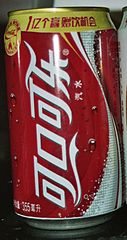We’ve all heard the horror stories about poorly researched business translation. Exxon, for instance, was appalled to learn that its brand in Japan, Esso, literally  means “stalled car” when spoken aloud in Japanese. Even Coca-Cola has fallen prey to poor translation; after installing thousands of billboards across Taiwan, Coca-Cola executives learned that the characters used to convey the brand name phonetically could mean either “A Female Horse Stuffed with Wax” or “Bite the Wax Tadpole.” Despite these cautionary tales of business translation service gone dreadfully wrong, there are still areas of gross oversight when it comes to translation. Today, we’re focusing on an especially underappreciated recipe for foreign marketing disaster: failing to carefully translate acronyms.
means “stalled car” when spoken aloud in Japanese. Even Coca-Cola has fallen prey to poor translation; after installing thousands of billboards across Taiwan, Coca-Cola executives learned that the characters used to convey the brand name phonetically could mean either “A Female Horse Stuffed with Wax” or “Bite the Wax Tadpole.” Despite these cautionary tales of business translation service gone dreadfully wrong, there are still areas of gross oversight when it comes to translation. Today, we’re focusing on an especially underappreciated recipe for foreign marketing disaster: failing to carefully translate acronyms.
Oftentimes, business leaders assume acronyms carry less risk than full-length brand names. However, business translation services can attest to the fact that acronyms also carry meaning and should therefore be selected carefully. The now-defunct power company PowerQuest understood the power of acronyms; when expanding into France, the company knew it had to come up with a new brand name, since in France, toilet paper is called PQ.
To show what can befall companies that fail to take PowerQuest’s thorough approach, we’ll tell the tale of Japanese steel manufacturer Sumitomo. The company dedicated copious amounts of money and time developing an extremely strong steel pipe that could be exported to major markets, including the U.S. The product was named Sumitomo High Toughness, shortened to “SHT.” While this acronym was completely benign to Japanese speakers, Americans couldn’t help but guffaw when they it plastered across promotional materials. What’s worse is that this acronym, smacking of a slang word for feces, was accompanied with the tagline “It was made to match its name.”
To avoid similar failures when advertising your products or services in foreign markets, we recommend working with a professional, experienced business translation service. Business translation services specialize in making sure brand names, acronyms and content won’t offend or otherwise repel overseas customers.
Here are a few specific steps you can take to ensure your acronym will be effective in your target culture:
Check the target language pronunciation of the acronym. A Japanese company named PPPhones, for instance, failed to consider how their name would sound to Americans. The Coca-Cola story listed above also falls into this category. One final humorous example: When General Electric Company merged with French company Plessey to offer telecommunications, the acronym GPT was selected (standing for GEC-Plessey Telecommunications). This was truly unfortunate, since the French pronounce GPT as “J’ai pété,” meaning, “I have passed gas.”
Research target language acronym connotations. Remember, other cultures use acronyms as well. If your acronym already has a local meaning, you’ll probably want to change your name for that market. For instance, when Calvin Klein sampled its new perfume “CK” on the streets of Lithuania, its testers were surprised to see that 70 percent of women responded with stiffness. However, their reticence makes sense given that the CK is also the acronym for the Central Committee of the defunct Lithuanian Communist Party.
Test internationally. Don’t limit your research to one or two target cultures. You never know where your brand will want to expand in the future. Enlist a business translation service to conduct an international test of your preferred acronym now, so as to avoid problems later.
[ Photo by: renaissancechambara, on Flickr, via CC License ]
